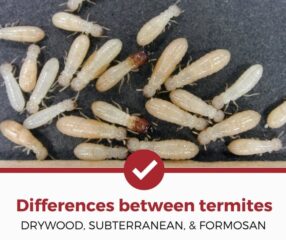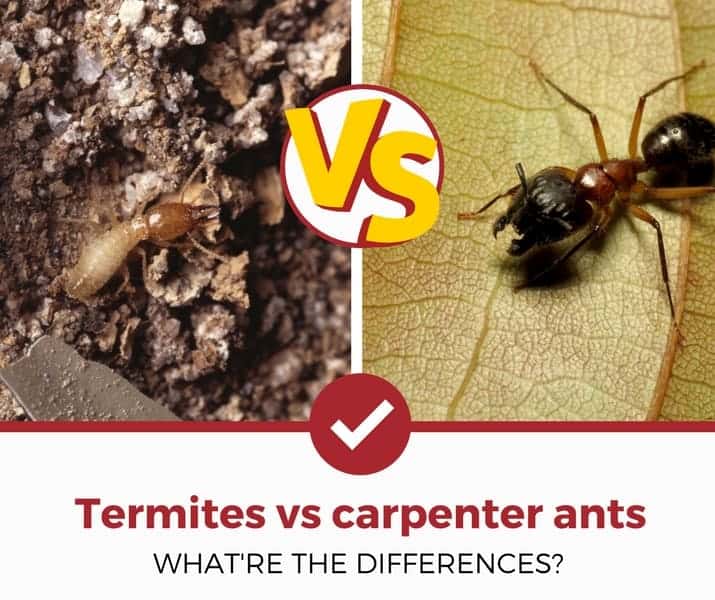How To Get Rid of Termites (Complete Guide)
Termites causebillions of dollars worth of damageeach year in the US. They feed off wood and cellulose products to weaken homes, buildings, and other structures. However, their control and management are often challenging.
First, you have to identify them correctly according to their species. Then, it’s vital to use strategies that will eliminate termites long-term. These methods can include liquid termite barriers, dry termite baits, and whole-structure fumigation.
In this extensive guide, we’ll tell you how to identify each termite species correctly. Then, you’ll learn how to manage them yourself. We’ll then give you some tips and tricks for hiring a professional. Finally, we’ll answer the most common questions asked by homeowners about getting rid of termites for good.

Ed has been working in the pest control industry for years helping 1,000's of homeowners navigate the world of insect and rodent management. He manages Pest Strategies now helping homeowners around the world!

Table of Contents
How to Identify Termites
Three types of termites are common in the US. Here, we’ll show you the difference between all three and give details about their features. Then, you’ll be able to tell them apart and identify each one correctly.
Subterranean termites
Some species of termites live underground in colonies and are calledsubterranean. They are the smallest of the three types, and they require constant contact with the moist soil to survive. They do this by building mud tubes between the ground and the infested structure.
Subterranean termites are present throughout the US and are broken down into eastern and western groups. However, both eastern and western subterranean termites are similar to each other. In addition, both species are made up of three primary castes:
- Workersare about a quarter-inch long. They have narrow, cream-colored bodies. And they are the ones that feed the colony. Because of that, the workers create all of the damage to a wooden structure.
- Soldiersare the protectors of the colonies. They staunchly defend the workers and their surroundings. And, their large, yellow heads and saw-like mandibles make them suitable for the task.
- Reproductivesare larger than the workers and soldiers. Both males and females have two sets of wings. After swarming, both pairs break off, showing evidence of an infestation.
Subterranean termites feed off of the following substances:
- Wood
- Paper products
- 死树的根
- Fallen tree limbs
- Wood piles
- Books
- Cotton
Subterranean termites are more common in some areas of the country than in others. Structures in the higher mountainous regions of North America have less incidence of termites. Also, the chance of infestation decreases if homes are treated during the construction phase.
Drywood termites
Drywood termites长度的两倍和四倍吗mass of subterranean termites. They can survive without contacting the soil. And they live deep inside the wood, so they’re hard to detect.
Drywood termites construct vast galleries to hide and lay their eggs. They also bore through the wood to build “kick-out” holes to discard their fecal material. These are small, oval-shaped pellets that are about one millimeter in length and have rounded ends.
Dampwood termites
Dampwood termites are the largest of the three species found in the US at almost one inch in length. Their cream-colored bodies may appear darker within the reproductive castes. And unlike other species, dampwood termites do not have a worker caste; it’s the nymphs that are in charge of feeding the colony.
Swarming termites often get confused with flying ants due to their similarities in appearance. However, termites have a wider body. Also, the wings of termites are equal, whereas the wings of ants are not.
Formosan termites
Formosan termites are not native species. They were initially introduced from the Hawaiian Islands and discovered in the 1980s. Formosan termites are larger than most species. And they eat through wood much faster.
For that reason, Formosan termite treatments require more materials to control them. Also, it could take much longer to eliminate them from homes and other structures.
Common Signs of Infestation
Termites are adept at hiding anywhere. Therefore, it could take a homeowner years to discover an infestation. Still, there are severaltelltale signsto look for when trying to discover if you have a termite problem.
Termite damage
Wood damage is the most obvious sign of termites. It can happen almost anywhere in the home. And it can show up as:
- Material weakness
- Termite galleries
- Warping
- Holes in walls and other areas
For example, baseboards, wood flooring, windows, and doors can all exhibit signs of warping. The high moisture content of termite infestations causes the wood to deform. Termites can also weaken it by chewing through several layers, resulting in the wood becoming thinner than usual.
Mud tubes
Some termites build mud tubes to stay in constant contact with the soil. They can go from the ground up to the structure or start from the home and hang down. Also, there are exploratory tubes that often run along pipes and appear to be unfinished. Mud tubes can form either inside or outside, usually along the home’s foundation.
Live termites
Finding live termites in a woodpile or a dead tree stump may not necessarily indicate an infestation in the home. However, it can tell you that termites are present or nearby. So, it’s crucial to investigate further.
Live termites behind walls and within the structure tell another story. You may have to plan on treating the home before they spread further. Also, live termites will give clues as to how large the infestation has become.
Droppings
Termite droppings are another sign you may have a termite problem. With most species, they appear as black or brown sawdust. Also, they may appear within extensive galleries or as piles beneath kick-out holes.
Swarmers
The presence of swarming termites in the spring could indicate an infestation. And a few may show up around your home. However, that doesn’t mean you have a termite problem. It’s just another sign that it’s possible.
Look for shed wings. After swarming, paired couples will shed their wings, signifying they’re monogamous. If there are several pairs of discarded wings around your home, it could warrant further inspection.

How to Identify Termites
Three types of termites are common in the US. Here, we’ll show you the difference between all three and give details about their features. Then, you’ll be able to tell them apart and identify each one correctly.
Find A Local Exterminator
How to Get Rid of Termites
Thefollowing stepswill assist you in your DIY methods. Keep in mind that it may require some special equipment and materials. And in some cases, such as with large infestations, it may be better to enlist the help of an exterminator.
Step 1. Inspection
By starting with a thorough inspection of the entire property, you understand where the termite activity is located. It also tells you the infestation level. And then you can decide on the proper course of action to get rid of it.
Start with the basement or crawlspace. Look for mud tubes and other signs of termite activity. Also, check for damaged blocks of wood or cardboard that termites may infest.
Next, check inside the house under sinks and wet areas where termites look for moisture content. Also, use a screwdriver to pry layers of rotten or damaged wood. Last, perform a complete inspection of outside areas, including:
- Foundation
- Exterior walls
- Porches, decks, patios
- Wood piles
- Adjacent structures
- Tree stumps or downed logs
Step 2. Barrier treatment
Liquid barrier treatments are the most common method for controlling termites.Termiticidessuch as Termidor and Taurus SC work well for long-term residual management.
First, you will have to dig a small trench around the entire home. Then, mix according to the proper dilution rate as per label directions. Next, fill the channel and let it sit according to label directions before covering.
In some instances, you can also trench the inside crawlspace for increased protection. With concrete, you will have to drill holes to access the soil underneath it. Then, using an injection attachment on your sprayer, soak the area thoroughly to create a barrier under the concrete.
Step 3. Spot treatment
Spot treatments are not a stand-alone solution but a suitable supplement to barrier treatments. For example, if you’ve discovered foraging termites under a sink area, a spot treatment may work well to eliminate the workers quickly.
This method helps to speed up the process of controlling the entire structure. Also, a spot treatment cuts off the colony until the ground-based termiticide has a chance to work.
Step 4. Crack and crevice treatment
In some instances, you can use crack and crevice applications of dry powders for residual termite control. These include mild, earth-based insecticides such as boric acid anddiatomaceous earth. However, keep in mind that these are additional treatments and should not be used for primary control.
Apply dry, insecticide materials to these areas for long-term, residual management:
- Wall voids
- Behind baseboards
- Pipe entry points
- Behind molding and window frames
Step 5. Baiting
Termite bait stations are a good choice for supplemental, long-term control of termites. However, they should never be used as a stand-alone treatment option.
Instead, bait stations work well as a holistic management approach combined with other strategies. In addition, you can use them to lure termites away from your home as a preventative measure.
Place the bait stations in-ground at regular intervals to attract termites. When workers eat the attractive substrate, they take the poison back to the colonies. And over time, the termites are eliminated.
Drywood termite treatment
有two primary treatment options for drywood termites:
Whole-structure fumigation
If your home is heavily infested with drywood termites,this treatment methodmay be your only option. It involves covering the house in tarps to make a tent-like structure.
Then, a toxic gas known as sulfuryl fluoride is introduced to kill the termites. The treatment lasts up to three days, and all occupants and pets have to vacate the structure. Only when gas levels are reduced to below five parts per million are the occupants allowed back in.
For obvious reasons, this is not a DIY project. In most states, only licensed and qualified exterminators are allowed to perform whole-structure fumigation.
Localized (spot) treatments
In some instances, you can perform spot treatments for drywood termites. This method only works for light infestation levels. Also, it takes a high level of accuracy to pinpoint a nested location.
It’s best to use aliquid foam application. Start by drilling 1/4″ holes into wall voids at four-foot intervals.
Next, apply the foam according to label instructions. You can also treat galleries and other infested locations directly using this method.
Dampwood白蚁治疗
Dampwood termite infestationsare typically small and don’t require chemical treatment. So, it’s best to remove the damaged wood areas.
Next, it’s vital to repair any leaky plumbing that caused the wood to rot. Also, be sure to provide proper ventilation to the affected area to prevent further infestation.
How to Prevent Termites
有several preventative measures you can take to ensure termites stay away from your home for good. Here are just a few examples.
Preventative termite inspections
Now that you know what signs to look for, you can perform your own preliminary inspections regularly. Still, it’s preferable to hire a licensed termite inspector. They have the education and skills to do a more complete assessment. Besides, if you decide to sell your home, you’ll need one, anyway.
Sanitation measures
Termites seek readily available sources of moisture. For that reason, it’s crucial to repair leaky plumbing. Also, water-damaged roofs can attract dampwood termites.
Consider moving firewood back at least 30 feet from your home. Termites tend to stay away from these areas if there are no sources of food available. In addition, it’s best to move mulch, cardboard, and paper materials to designated storage areas away from exterior walls.
Home repair
Some termite species thrive on rotting wood. That’s why it’s vital to repair rotted wood structures. And don’t forget untreated decks and porch areas. These areas can attract termites, also.
Pre-construction termite treatments
之前建立一个家,可以考虑使用一些pre-construction termite prevention measures. Here are some of the most common examples:
- Termite shielding between the foundation and support beams
- Slab collars for plumbing and electrical entry points
- Stainless steel foundation barriers
- Use treated lumber in all areas of the home where available
Termite traps
Cardboard traps don’t work for termites. That’s because there are none on the market with the proper attractant. Also, there may be too many termites within a colony. Still, new technologies may one day render termite traps an effective solution.
Top Recommended Companies for Termite Control
这里有一些的p termite control companies in the US. However, this is not an exhaustive list, so be sure to check your local listings. Still, these three companies are the best rated for termite service anywhere.
- Terminixis the first company to patent termiticide for long-term control of termites. With almost 90 years of industry experience, this company has the knowledge to eliminate any size infestation. And it shows by continually training its technicians in the latest eco-friendly termite control methods.
- AptiveEnvironmental is the newcomer to the pest control industry. But that doesn’t mean it’s inferior in any way. Its annual growth proves it will do what it takes to keep customers happy.
- Orkin’stermite division is one of the best in the world. It performs barrier, foam, and fumigation treatments. And it’s one of the few companies left that can locate a termite colony in a short amount of time. Orkin’s general pest control service is also rated very high.
Termite Control FAQs
Can termites destroy a home?
It’sunlikelythat termites will eat through an entire house. However, they could weaken the structure enough to cause severe damage. And it could get so bad that a home can topple to one side or the other.
Will termites go away on their own?
Termites will not usually disappear once they’ve established a colony within your home. That’s why it’s essential to contact a reputable pest control company right away if you suspect termites. These licensed professionals can offer an inspection and sometimes a free quote.
What do termites hate?
Heat and sunlight are the two biggest enemies of termites. Also, not having enough food and moisture is another. So, it’s best to eliminate water leaks around a structure and keep food sources away from potential infestations.
有some natural repellents termites hate, such as orange oil. Vinegar and borax will also deter certain species. However, these substances have not been proven effective as natural pesticides, especially for termites.
Is it safe to live in a house with termites?
Termites typically don’t attack or bite people. However, winged swarmers can become annoying. And if left untreated for several years, termites can cause widespread damage. That’s when a home can become dangerous to occupy.
How fast do termites spread?
The rate at which future infestations can occur depends on several factors, including:
- Species
- Region
- Local conditions
- Type of structure
- Prior prevention methods
For example, Florida has thegreatest concentrationsof termites in the US. However, Nebraska has the fewest. Therefore, the northern parts of the US will have fewer incidents of termites than the southern regions.
Also, if a homeowner pre-treats their house before it’s built, it will slow the spread of termites. Likewise, homes that are older and in vulnerable areas are more likely to become infested.



